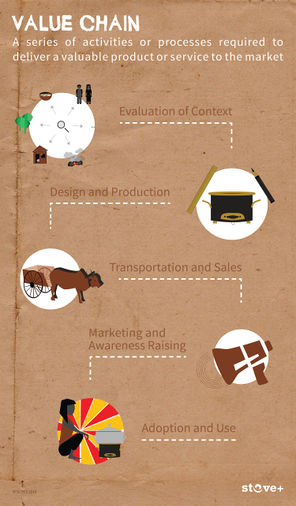Knowledge fuels change - Support energypedia!
For over 10 years, energypedia has been connecting energy experts around the world — helping them share knowledge, learn from each other, and accelerate the global energy transition.
Today, we ask for your support to keep this platform free and accessible to all.
Even a small contribution makes a big difference! If just 10–20% of our 60,000+ monthly visitors donated the equivalent of a cup of coffee — €5 — Energypedia would be fully funded for a whole year.
Is the knowledge you’ve gained through Energypedia this year worth €5 or more?
Your donation keeps the platform running, helps us create new knowledge products, and contributes directly to achieving SDG 7.
Thank you for your support, your donation, big or small, truly matters!
A Study on Biomass Cookstove Business Models from Asia and Africa
Introduction
Early efforts to disseminate cleaner and more efficient cookstoves to those at the Base of the Pyramid (BoP) in developing countries were mostly subsidized through Official Development Assistance (ODA) and development programs. Many for-profit initiatives, which emerged during the 1990s, succeeded in achieving financial soundness and were able to disseminate improved cookstove (ICS) technologies while generating local economic value.
This paradigm shift, reframing the energy access gap into a largely untapped market, drives the stove industry today. While it is largely shared among practitioners that a market-based approach is a pre-requisite for sustainable and scalable cookstove dissemination, it is not clear to which extent the level of public and private investments along the overall value chain contribute to the long-term sustainability of market actors.
A Study to Increase Knowledge on Cookstove Business Models
In early 2014, StovePlus and GIZ-HERA initiated a study to better understand biomass cookstove business models across Asia and Africa.
Focusing on investment choices and flows, researchers aimed to bring recommendations from major market actors to the sector’s financers, such as donors and private investors, and lessons learned to practitioners in the sector.
They sought to find answers to the complex question “when, how and where should public and private investment be leveraged to achieve sustainable large-scale ICS/ACS distribution to end users?” They found that the answer to this question depends on a variety of factors, including the type of initiative implemented (NGO supported vs. social enterprise vs. private entity), the business phase (start-up vs. scale-up), market readiness, available financing mechanisms and the local socio-cultural context. Market maturity was found to be an especially important factor to consider in making strategic investment decisions in cookstove businesses.
What Financing Mechanisms were Used?
A variety of financing mechanisms were seen, such as Official Development Assistance (ODA), private loans, carbon finance, awards, etc. However, the most common across all the cases was carbon finance. Carbon finance played a very important role in the ability to scale-up cookstove businesses, yet given the recent collapse in carbon markets it may pose a threat to business models that are highly dependent on the sale of carbon credits.
Access to finance is vital for the development of cookstove businesses and the sector, and direct investments into cookstove value chains have made stoves more accessible to end users. Market actors mentioned the importance of subsidies (i.e. any type of financial assistance reducing the cost of stoves to end users) in their growth and success, though the manner in which they are implemented must be carefully assessed. The study also explores the very interesting case of Cookswell Jiko; a cookstove business that was able to reach scale without any financial assistance.
What Role Can Donors Play?
Despite a shift towards more market-based approaches, donors are still very relevant and have an important role to play in the development of the cookstove sector. In particular, market actors are calling upon development agencies and governments to lead large-scale, national level awareness raising efforts on the impacts associated with inefficient cooking, in particular the effects of Indoor Air Pollution (IAP) on human health.
There are different approaches to identify the most suitable inclusive distribution strategy, for both international programmes and private companies.
Methodology
The study, “Building Business Cases to Reach Scale: A study on biomass cookstove business models from Asia and Africa”, analyzed the following 8 cookstove business models:
- IcoProDac, GERES Cambodia
- SZ Consultancy, GIZ Bangladesh
- Envirofit India
- Envirofit Kenya
- Cookswell Jiko, Kenya
- Toyola Energy Ltd., Ghana
- EnterpriseWorks/ VITA, Ghana
- FAFASO, GIZ Burkina Faso
Cases were selected based on a set of technical criteria determined by a panel of stove experts from Asia and Africa and analyzed using the Energy Delivery Model Framework developed by Wilson et al. 2012 to describe the delivery of energy services.
By conducting 100 in-person interviews, direct field observations, focus groups and two regional workshops (Phnom Penh, Cambodia and Accra, Ghana), researchers were able to gather a large amount of firsthand data and recommendations.
Explore the cases and increase your knowledge on cookstove business models!
Download
Read or download the study here:
Further Information
- StovePlus
- GIZ-HERA - Poverty-Oriented Basic Energy Services
- Global Alliance for Clean Cookstoves
- Inclusive Energy Distribution Strategies for Energy Access Programmes and Companies
References
- Albi, Emily and Andrew E. Lieberman. (2013). “Bringing clean energy to the base of the pyramid: The interplay of business models, technology and local context” Journal of Management for Global Sustainability (2): 141-156.
- Bellanca, Raffaella and Ben Garside. (2013). “An approach to designing energy delivery models that work for people living in poverty” (IIED Report 16551). Retrieved from http://pubs.iied.org/16551IIED.html
- Wilson, Emma, Neha Rai and Sarah Best. (2014). “Sharing the load: Public and private sector roles in financing pro-poor energy Access” (IIED Report) Retrieved from: http://pubs.iied.org/16560IIED.html





















